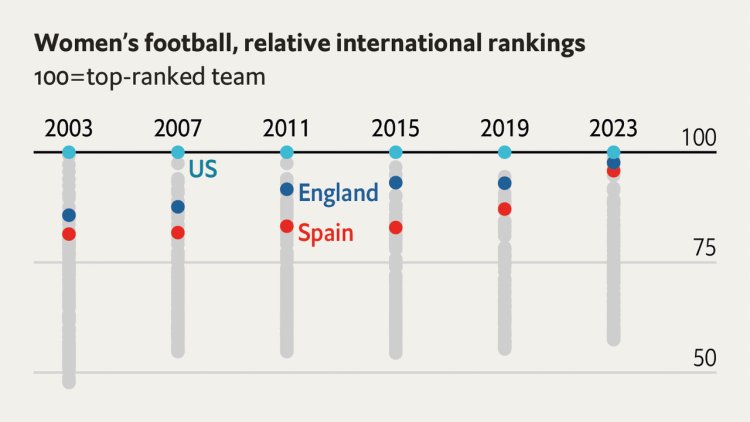Women’s football is becoming bigger and better
Corals are bleaching and dying earlier in the year than ever beforeScientists are evacuating corals off the coast of Florida to save themTo read more of The Economist’s data journalism visit our Graphic detail page.TO UNDERSTAND THE evolution of women’s football, look at the World Cup, the sport’s most prestigious prize. The first men’s tournament took place in 1930; women only got their version in 1991. That edition, held in China, featured just 12 teams. This year’s tournament, the ninth, which is being held in Australia and New Zealand, has 32. It took the men 16 tournaments to reach this size. And contrary to pre-tournament fears, the expansion has not compromised quality or diluted competition. Just ask the Americans. In the 1991 tournament America steamrolled their opponents, winning all six of their games with an aggregate score of 25-3. They have won four World Cups and dominated the sport’s rankings. But others are catching up. In this year’s tournament they managed to win onl


Corals are bleaching and dying earlier in the year than ever before
Scientists are evacuating corals off the coast of Florida to save them
To read more of The Economist’s data journalism visit our Graphic detail page.
TO UNDERSTAND THE evolution of women’s football, look at the World Cup, the sport’s most prestigious prize. The first men’s tournament took place in 1930; women only got their version in 1991. That edition, held in China, featured just 12 teams. This year’s tournament, the ninth, which is being held in Australia and New Zealand, has 32. It took the men 16 tournaments to reach this size. And contrary to pre-tournament fears, the expansion has not compromised quality or diluted competition.
Just ask the Americans. In the 1991 tournament America steamrolled their opponents, winning all six of their games with an aggregate score of 25-3. They have won four World Cups and dominated the sport’s rankings. But others are catching up. In this year’s tournament they managed to win only one match before being knocked out in the round of 16 for the first time, by Sweden. There will be new champions. On August 20th England and Spain will both contest their first final.
Women’s international-team rankings, which are calculated by FIFA, the sport’s governing body, demonstrate the growth of the game. The first rankings were calculated in 2003, and only included teams that had played at least five international matches before 1999. That meant only 108 teams featured in the inaugural list. Today there are 188 (compared with 208 in the men’s rankings).
Not only are there more teams, their ranking points are also more narrowly distributed, suggesting tighter competition. In 2003 America’s score was 2.1 times that of the 100th-ranked team (Puerto Rico). Before this World Cup began America was only 1.7 times better than the 100th-ranked team (the Faroe Islands). The distribution is approaching the men’s game where Argentina, the world champions, score roughly 1.5 times higher than 100th-ranked Lebanon.
In both England and Spain the top women’s domestic leagues are emerging out of the shadow of their male counterparts. Attendances at women’s games have soared. Last year Barcelona, the Spanish champions, played Wolfsburg, a German side, in front of more than 91,000 people—the most ever at a women’s football match and possibly any women’s sporting event. Interest is spreading to the grassroots level. In England the number of girls seen playing football every day during school breaks rose from 22% in July last year to 32% this July, according to a survey of teachers.
Though such progress is remarkable, it comes from a low base. Chelsea, who won the English Women’s Super League last season, drew an average attendance of around 6,000 last season; their male counterparts averaged 40,000. Professional women’s football is relatively new. Only 40% of those playing in the qualification stages of the World Cup were professional and around 30% reported not receiving a payment from their national federations, according to a survey by FIFPRO, the players’ union.
The numbers are starkest in poor countries where opportunities for women are even harder to come by. In Nigeria’s women’s football league, for instance, teams play just 12 games a season. As a result, the Nigerian squad played around 40,000 minutes of high-level football in the year before the World Cup, roughly a third less than the English and the Spaniards. The playing field for women’s football may be getting bigger, but it is far from level.■
What's Your Reaction?













